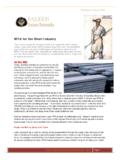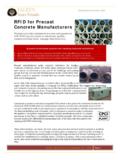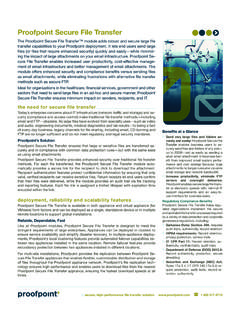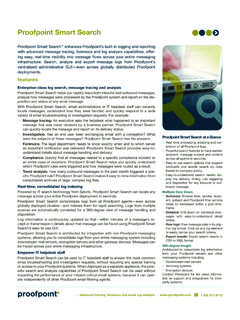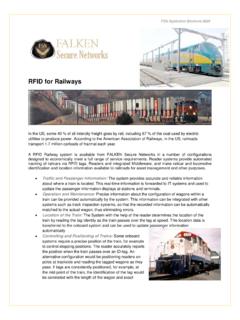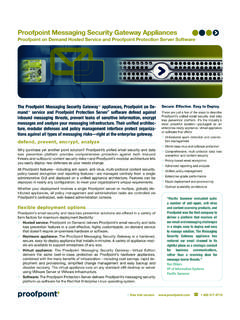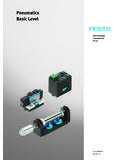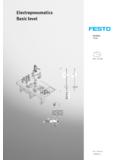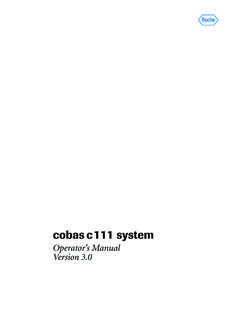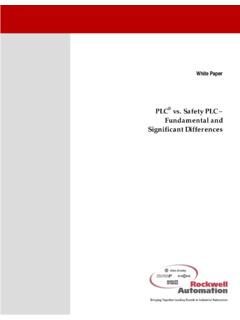Transcription of RFID for Construction Sites And Facilities …
1 FSN Application Brochure 0833 RFID for Construction Sites And Facilities management Construction Sites are challenging environments to manage with many critical questions to answer: 'Where is Frank? - We need him right now.'. 'How many Part ABC are currently on hand? - We need twenty or we can't start the next phase. 'Where is Part 123? - The crew is waiting.'. What is the Warranty date on that part?'. To meet these challenges, more and a more Construction companies and site contractors are benefiting by integrating RFID technology in their day-to-day operation of Construction Sites and projects. The ROI is amazing for so many aspects of this industry. When RFID is used properly you will end up utilizing all of your resources more effectively. The impact to the bottom line will be dramatic.
2 RFID has found its way into almost every corner of today's fast moving, always looking for increased efficiency, world. FSN has the right RFID technology for your Construction business requirements. By combining the latest in passive and active RFID with Omnitrol's edge appliance and middleware solution available from FSN, your operation will quickly enjoy the benefits of this new enabling technology. You know your business the best. Here are some common 'pain points' that the Construction industry is wrestling with and that can profit through the use of RFID: Labor Efficiency/Productivity Reducing Product Obsolescence Costs Out-Of-Stock management Tracking and Managing Spare Parts Inventory management Inventory Receiving Shipping Accuracy Facilitating Statistical Process Control Reduced Claims Enabling Lot/Batch Track and Trace Reduced Non-usable Items Ensuring Worker Safety Reduced Diversion Reducing Returns and Warranty Claims Product Recall management Reducing Scrap.
3 Waste and Better Visibility Obsolescence Better Fulfillment Better Planning and Forecasting Product Integrity Better Processes in Vendor Managed Page 1 FSN Application Brochure 0833 Increasing Capacity Utilization and Inventory Yield Systems Related to Reordering Reducing Cycle Time Traceability and Safety of Products by Improving Product Quality Avoiding Ensuring Timely Preventative Counterfeiting Maintenance Better Asset management and Handling of Returnable Assets Increasingly, developers and building owners are seeing the benefits of integrating RFID into the Construction phase with a view that such RFID and sensor enablement will automate many aspects of the Facilities management , especially energy management , once the building is operational. With Omnitrol's built-in middleware and set of customer defined business rules, actions are implemented automatically when the RFID Readers detect certain real-time threshold conditions.
4 In various reviews of the Construction Industry, a number of potential application areas for RFID. technology have emerged. These included component tracking, inventory management (small tools as the example) and equipment monitoring. Suggested applications for the future include guided control of equipment and maintenance applications, tags that can communicate temperature, vibration, fatigue or excessive stress in concrete and steel members, and concepts for safety management . As a result of large allocations of R&D investments, the technology has rapidly evolved and improved in quality in just the last 2 or 3 years as well as witnessing significant cost reductions. Ideally, the RFID tags for Construction applications could also be planned for utilization for management of the completed facility, thereby further enhancing the justification for the expenditure on the RFID.
5 System and, importantly, adding value to the facility by automating or at least simplifying the Facilities management process. Indeed, asset tagging and tracking and energy management are frequently cited as applications from which real value could be added to the management of Facilities . Before examining individual applications, it is instructive to note the broader picture and understand the implications of introducing RFID technology into the Construction sector generally. Three broad areas are involved: 1. Value and supply chains in the Construction process, including the subsequent management of Facilities . 2. RFID technology its practical implementation and the results produced. 3. Handling the large quantity of data generated by RFID systems and the use of agent technology.
6 THE Construction SECTOR VALUE CHAIN. 1. Recognizing the value chain The drive towards more efficient Construction is well illustrated by examining the value chain, which follows the lifecycle of a building from raw materials through to the management of the completed facility. Construction projects today more and more less frequently follow the conventional ( linear) model where completed buildings were handed over to the owner. Today, it is not uncommon for the constructor to retain a measure of control either as part-owner or as the operator of the asset or facility, as would occur under various integrated procurement routes. In this way, the cost efficiency of the completed facility becomes the constructor's responsibility and so it is as important to manage the facility as if it were the Construction phase perhaps more so.
7 Page 2 FSN Application Brochure 0833 2. Value chain modeling A company's core competences can be determined by using a value chain model to analyse where cost advantages can be gained in performing activities. Value chain modeling separates the business system into a series of value-generating activities subdivided into primary and support activities 3. Security control of access to Facilities management of Facilities requiring control of access may use RFID tags attached to employees' ID. badges; this method is already in use in hotels and commercially sensitive Sites to permit/control staff access to specific areas. Safety requirements also requires real-time data on all personnel on site at all times. FSN can integrate the RFID location system with infrared motion sensors which trigger tracking cameras enabling, for example, the identification of unauthorized access.
8 4. Inventory Control of inventory is one of the widest application areas of RFID technology, and is used for applications ranging from hand-tool logging on Construction Sites to parts and building materials. 5. Construction site delivery logistics and materials tracking Materials tracking management systems are able to provide site managers with the ability to determine Construction progress and materials delivered from centralized reports or by simply walking around a site where all materials are identified and tagged using an RFID system. This would guarantee more accurate estimates of the number and quantity of delivered goods and enable reliable monitoring of percentage Construction complete'. The RFID system is seen to show the way to several improvements. 1. Reduction of costs incurred from wastage of materials, theft and check-in waiting times for material.
9 2. Agent technology enhances communications by informing the driver immediately where the material is to be placed. The agent will confirm delivery of the material with the supplier via the internet and the supplier's website or e-mail address as soon as the material is sent through the delivery gate. The site engineer will be informed as soon as material has arrived on site and can respond and issue further instructions if necessary. If there are any discrepancies, the driver will be informed as will the supplier. The key point to note is that this communication will be immediate, so any problems can be resolved as soon as they become apparent. 3. Time savings will result due to efficient document management . There should be less paperwork, no invoices for the delivery personnel to complete, as all will be automated by the system.
10 Information will be in electronic form and include instructions for the vehicle driver to follow. Multiple handling of documents will be significantly reduced. 6. Document tracking RFID technology can be used for rapid document tracking, essential in the Construction phase to identify the latest version of files and drawings, and also in the Facilities management phase to locate original build specifications and layouts. Each document is tagged with an adhesive smart label (RFID printed circuit) that contains a unique ID together with human readable information. The file description is entered into a database along with its tracking number and can be assigned certain parameters like expiration date, permitted movement and personnel authorized to see it. Over time, the database could build up an audit trail of the handling and workflow history of each document file.
